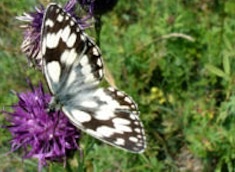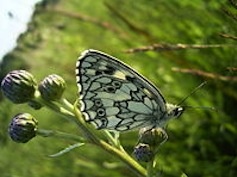Butterflies on Magog Down
This article is from our archives; it was written in 1994.

As the flora of the Down becomes consolidated and is enhanced by new planting, it is to be hoped that a good butterfly population will establish itself by natural means, that is, as resident species which are common in the Cambridge area spread into it. These should include the large handsome Vanessids, both British residents – Small Tortoiseshell and Peacock, and the scarcer Comma – and the regular migrants – Red Admiral and Painted Lady – of which the first four have larvae requiring nettles, and the last named thistles. These are all powerful fliers and wander widely, so that even without nettles or thistles on the site, the adults will visit it (especially from July to September) to sip nectar from a variety of flowers.
It is also likely that the three common Whites – Large, Small (these two much reinforced in some years by migration from the Continent), and Green-veined – regularly be seen, and that several of the common Browns whose larvae feed on grasses will move in at an early stage: Meadow Brown, Hedge Brown (or Gatekeeper), Small Heath, and Wall. The diminutive Skippers also have grass-feeding larvae and should appear soon: the Large, Small, and possibly the Essex.
 In years when it migrates in numbers (the last time was 1983) from the Mediterranean basin the Clouded Yellow is also a typical downland insect, specially attracted to fields of clover, the larval food plant. One would expect to see quite soon resident populations of the Common Blue (associated with vetches) and Small Copper (docks and sorrels). Finally, the elegant Brimstone may appear anywhere, often far from any hedgerow or woodside containing the foodplant, buckthorn.
In years when it migrates in numbers (the last time was 1983) from the Mediterranean basin the Clouded Yellow is also a typical downland insect, specially attracted to fields of clover, the larval food plant. One would expect to see quite soon resident populations of the Common Blue (associated with vetches) and Small Copper (docks and sorrels). Finally, the elegant Brimstone may appear anywhere, often far from any hedgerow or woodside containing the foodplant, buckthorn.
Other developments are more problematical. We know from records gathered in the Victoria County History, and from memories such as my own (from student days in the early 1950s) what the old downland of the Gogs once sustained, and we can study it still in a relatively undisturbed state not far away at Royston; also of course in well-endowed localities on the North and South Downs, in Dorset, etc. It is then a question of whether the Magog Trust area is large enough to sustain other species, and also whether specific requirements can be met.
Some excellent research in the last twenty years has shown that some butterflies are quite extraordinarily demanding when they lay their eggs (plants of a certain height in special conditions of light and shade being chosen, for example); and what may benefit one foodplant and therefore its associated insects may not suit another. It is then the case that it will be worth attempting artificial introductions of downland insects – Chalkhill Blue (foodplant: horseshoe vetch), Small Blue (kidney vetch), Marbled White (grasses), come to mind at once – only if proper conditions can be met and sustained. Such introductions are only undertaken after consultation with national authorities, and the subject is a delicate one. The typical downland moths will be the subject of a later note. Meanwhile, let us hope that at least some of the above predictions are fulfilled during summers to come.
